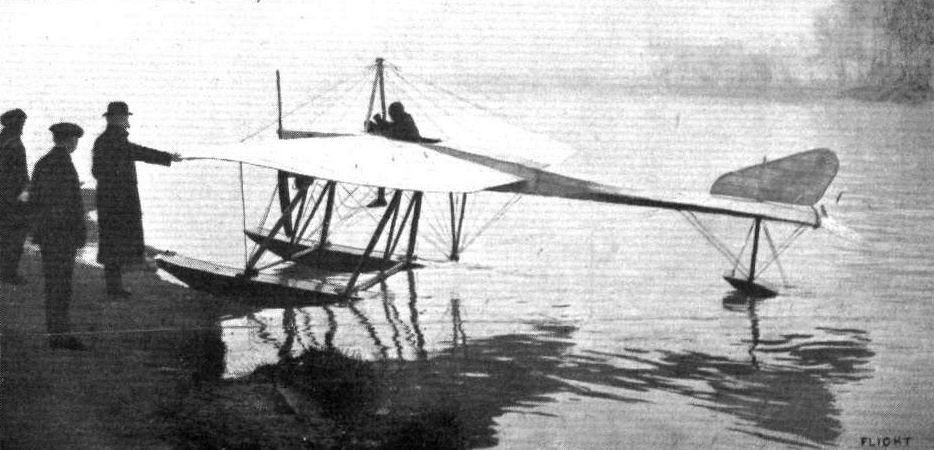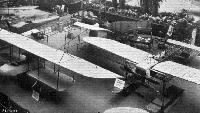Журнал Flight
Flight, January 18, 1913.
FOREIGN AVIATION NEWS.
A Bleriot Hydro-Aeroplane.
OVER the Seine between Bezons and Argenteuil on Saturday last some trials were made with a hydro-avion built in the Bleriot works. Perreyon was in charge of the machine which is, of course, a monoplane, with two seats side by side. It is fitted with an 80-h.p. Gnome, and there are two main floats, with an auxiliary float to support the tail. MM. Louis Bleriot and Alfred Leblanc supervised the trials, which included some fifteen flights of varying duration, some with passengers, and among the interested spectators were "Beaumont" and MM. Donnet and Leveque.
Flight, November 29, 1913.
THE NEW BLERIOT HYDRO-AEROPLANE.
ONCE more the Seine at Billancourt has been the scene of experiments with hydro-aeroplanes by M. L. Bleriot; it will be recalled that as far back as in 1906 M. Bleriot experimented in the same neighbourhood with a biplane having elliptical main planes.
The new hydro-aeroplane is of the tandem two-seater type. One of our photographs shows the chassis, which consists of the usual Bleriot chassis with the addition of a few extra tubular struts which support the front portion of the Tellier floats with which this machine is equipped. These floats are sprung in a similar way to the wheels of the land machine, being pivoted around the transverse tube which connects the front chassis struts and being sprung at the rear by means of the usual shock absorbers. This arrangement has, of course, the advantage of lessening the shock of alighting very considerably, and has in the preliminary tests proved very successful. The machine can be converted into a land machine by substituting wheels for the floats, an operation which, we understand, can be carried out in less than an hour.
The tail is supported on the water by means of a float which forms an extension of the rudder and by means of which the machine can be steered on the water.
At the trials an 80 h.p. Le Rhone engine was fitted, and, in the hands of the late M. Perreyon, the machine rose in less than a hundred yards, and flew at a speed of about 100 kilometres an hour. The span of the machine is 11 metres, and she weighs, empty, about 700 lbs. With pilot and passenger and 4 hours' fuel on board, the weight is about 1,400 lbs.
Flight, December 13, 1913.
THE STANDS AT THE PARIS AERO SHOW.
BLERIOT.
On the Bleriot stand are shown no less than six machines and fuselages of various types, and when one considers that there are at the Salon two more Bleriot stands - one for aeroplanes and one for bateaux glisseur - one begins to realise the activity of this well-known firm.
<...>
The hydro-monoplane follows in general lines the land machines. It is a tandem two-seater of the light type; so light, in fact, that only an 80 h.p. Gnome engine is fitted. It must not from its lightness be concluded, however, that it is not a strong machine, for the method of suspension is such that the shock of alighting is very much lessened before it reaches the fuselage, thus making it possible to keep down the weight of that structure. The two Tellier floats with which this machine is fitted swivel round a common axis running across their front portion and are sprung at the rear by means of the usual Bleriot deformable triangle. Each float moves independently of the other, and the upward travel of the floats is 35 centimetres, so that it will be seen that even in case of a very rough amerrissage the shock is greatly diminished both as regards the fuselage and the floats.
<...>
Flight, December 20, 1913.
THE PARIS AERO SALON - 1913.
BLERIOT.
<...>
The hydro-monoplane follows in its general lines the construction of the land machine, and a detailed description of the machine itself is therefore not necessary. Suffice it to say that it is driven by a 9-cyl. 80h.p. Le Rhone engine, which has, owing to the light weight of the machine, been found sufficiently powerful for the purpose. The main interest attaches to the chassis and floats. These latter, which are of the plain, non-stepped type, are attached to the fuselage by means of the usual Bleriot chassis, with the addition of a few extra struts, which support the front transverse steel tubes round which the floats are pivoted. Each float moves independently, the amount of upward travel being 35 centimetres, and they are orientable similarly to the wheels of the land machines. This impresses one as being an excellent feature for alighting on the water in a side wind, as it will probably allow the machine to slide along slightly sideways without upsetting it, thus acting in a similar manner as the swivelling wheels of the land machine. One gathers that the operation of substituting wheels for the floats, or vice versa can be accomplished in a comparatively short time, thus changing it into a land machine.
When the machine is resting on the water, the tail is supported by a tail float of three-ply wood, rigidly attached to the fuselage, and the rudder is extended some distance downwards to allow of steering on the water when taxying. The workmanship is of the highest quality in all of the exhibited machines, and one leaves this stand with a feeling of admiration for the activity and enterprise of the Bleriot firm.
Flight, March 14, 1914.
WHAT THERE WILL BE TO SEE AT OLYMPIA.
THE EXHIBITS.
Bleriot (L. Bleriot). (60.)
M. BLERIOT will have a most comprehensive exhibit, no less than four machines being shown, as well as sand yachts.
<...>
In the remaining machine, which made its appearance at the Paris Aero Show (See FLIGHT December 20th, 1913), is a "coque fuselage " monoplane, and is a speed machine, capable of travelling at 75 miles per hour and climbing at the rate of over 450 ft. per minute. It normally carries sufficient fuel to last for four hours, and is a two-seater, the observer being placed behind the pilot, and by lying down in the fuselage can observe the country over which the machine may be travelling, through an aperture in the bottom of the coque. A speaking tube, fitted with a microphone, is fitted to enable the passenger to communicate with the pilot.
The Bleriot sand yachts will complete a very interesting exhibit.
Flight, March 21, 1914.
THE OLYMPIA EXHIBITION.
THE EXHIBITS.
BLERIOT L. (BLERIOT). (69).
NEATLY displayed on the largest stand at the Show are the Bleriot monoplanes - a tandem two-seater of the well-known type, a hydro-monoplane, and a single-seater military monoplane.
<...>
The 80 h.p. Seaplane does not differ materially from the machine exhibited at the Paris Show and fully described in our report at that time. One of the chief alterations appears to be a shortening of the chassis by carrying the cross member under the lower longerons instead of, as then, under the upper longerons.
The chassis is illustrated by the accompanying sketches and photographs which are self explanatory.
The two main floats, of the non-stepped type, have been built by the well-known Tellier firm.
A small float protects the tail planes against contact with the water, and a water rudder mounted on an extension of the rudder post enables the machine to be steered when taxying at low speeds.
The two seats are arranged tandem fashion as in the land machines, but appear to have been moved closer together, no doubt with a view to reducing the longitudinal moment of inertia. The same applies to
<...>















